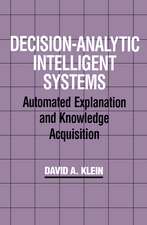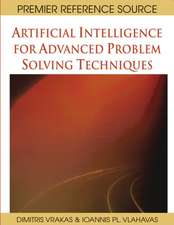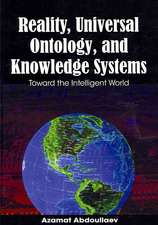Knowledge-Based Explorable Extended Reality Environments
Autor Jakub Flotyńskien Limba Engleză Paperback – 9 dec 2021
The E-XR approach proposed in this book relies on two main pillars. The first is knowledge representation technologies, such as logic programming, description logics and the semantic web, which permit automated reasoning and queries. The second is imperative programming languages, which are a prevalent solution for building XR environments. Potential applications of E-XR are in a variety of domains, e.g., education, training, medicine, design, tourism, marketing, merchandising, engineering and entertainment.
The book’s readers will understand the emerging domain of explorable XR environments with their possible applications. Special attention is given to an in-depth discussion of the field with taxonomy and classification of the available related solutions. Examples and design patterns of knowledge-based composition and exploration of XR behavior are provided, and an extensive evaluation and analysis of the proposed approach is included.
This book helps researchers in XR systems, 3D modeling tools and game engines as well as lecturers and students who search for clearly presented information supported by use cases. For XR and game programmers as well as graphic designers, the book is a valuable source of information and examples in XR development. Professional software and web developers may find the book interesting as the proposed ideas are illustrated by rich examples demonstrating design patterns and guidelines in object-oriented, procedural and declarative programming.
| Toate formatele și edițiile | Preț | Express |
|---|---|---|
| Paperback (1) | 644.98 lei 6-8 săpt. | |
| Springer International Publishing – 9 dec 2021 | 644.98 lei 6-8 săpt. | |
| Hardback (1) | 651.23 lei 6-8 săpt. | |
| Springer International Publishing – 8 dec 2020 | 651.23 lei 6-8 săpt. |
Preț: 644.98 lei
Preț vechi: 806.23 lei
-20% Nou
Puncte Express: 967
Preț estimativ în valută:
123.44€ • 127.89$ • 103.01£
123.44€ • 127.89$ • 103.01£
Carte tipărită la comandă
Livrare economică 21 martie-04 aprilie
Preluare comenzi: 021 569.72.76
Specificații
ISBN-13: 9783030599676
ISBN-10: 3030599671
Ilustrații: XVI, 268 p. 92 illus., 44 illus. in color.
Dimensiuni: 155 x 235 mm
Greutate: 0.4 kg
Ediția:1st ed. 2020
Editura: Springer International Publishing
Colecția Springer
Locul publicării:Cham, Switzerland
ISBN-10: 3030599671
Ilustrații: XVI, 268 p. 92 illus., 44 illus. in color.
Dimensiuni: 155 x 235 mm
Greutate: 0.4 kg
Ediția:1st ed. 2020
Editura: Springer International Publishing
Colecția Springer
Locul publicării:Cham, Switzerland
Cuprins
1. Introduction.- 2 Extended Reality Environments.- 3. Knowledge Representation with Logical Systems.- 4. Ontology-Based Creation of Extended Reality.- 5 E-XR: Explorable Extended Reality Environments.- 6. E-XR Visual Knowledge-Based Behavior Model.- 7. E-XR Semantic Link Model.- 8. E-XR Development Pipeline of Explorable Environments.- 9. E-XR Exploration Methods.- 10. E-XR Development Tools for Explorable Environments.- 11. Applications of E-XR.- 12. Evaluation of E-XR.- 13 Conclusion.
Notă biografică
Jakub Flotyński is a researcher in the Department of Information Technology at the Poznań University of Economics and Business, Poland. His research interests are focused on the intersection of virtual, augmented and extended reality (XR) and knowledge representation technologies, including the semantic web, description logics and logic programming. He is the author or co-author of 50 research papers and has participated in multiple research and industrial projects in these fields. He is also a Co-Chair of the X3D Semantic Web Working Group in the Web3D Consortium, which contributes to the development of principal solutions in the field of semantic knowledge-based XR systems and 3D content formats.
Textul de pe ultima copertă
This book presents explorable XR environments—their rationale, concept, architectures as well as methods and tools for spatial-temporal composition based on domain knowledge, including geometrical, presentational, structural and behavioral elements. Explorable XR environments enable monitoring, analyzing, comprehending, examining and controlling users’ and objects’ behavior and features as well as users’ skills, experience, interests and preferences.
The E-XR approach proposed in this book relies on two main pillars. The first is knowledge representation technologies, such as logic programming, description logics and the semantic web, which permit automated reasoning and queries. The second is imperative programming languages, which are a prevalent solution for building XR environments. Potential applications of E-XR are in a variety of domains, e.g., education, training, medicine, design, tourism, marketing, merchandising, engineering and entertainment.
The book’s readers will understand the emerging domain of explorable XR environments with their possible applications. Special attention is given to an in-depth discussion of the field with taxonomy and classification of the available related solutions. Examples and design patterns of knowledge-based composition and exploration of XR behavior are provided, and an extensive evaluation and analysis of the proposed approach is included.
This book helps researchers in XR systems, 3D modeling tools and game engines as well as lecturers and students who search for clearly presented information supported by use cases. For XR and game programmers as well as graphic designers, the book is a valuable source of information and examples in XR development. Professional software and web developers may find the book interesting as the proposed ideas are illustrated by rich examples demonstrating design patterns and guidelines in object-oriented, procedural and declarative programming.
The book’s readers will understand the emerging domain of explorable XR environments with their possible applications. Special attention is given to an in-depth discussion of the field with taxonomy and classification of the available related solutions. Examples and design patterns of knowledge-based composition and exploration of XR behavior are provided, and an extensive evaluation and analysis of the proposed approach is included.
This book helps researchers in XR systems, 3D modeling tools and game engines as well as lecturers and students who search for clearly presented information supported by use cases. For XR and game programmers as well as graphic designers, the book is a valuable source of information and examples in XR development. Professional software and web developers may find the book interesting as the proposed ideas are illustrated by rich examples demonstrating design patterns and guidelines in object-oriented, procedural and declarative programming.
Caracteristici
Describes the concept, architectures, methods and tools for the spatial-temporal composition of XR environments Presents an approach based on knowledge representation technologies and imperative programming languages Written mainly for researchers, graduate students and advanced developers in XR systems, 3D modeling tools and game engines






















